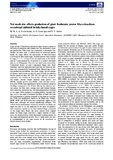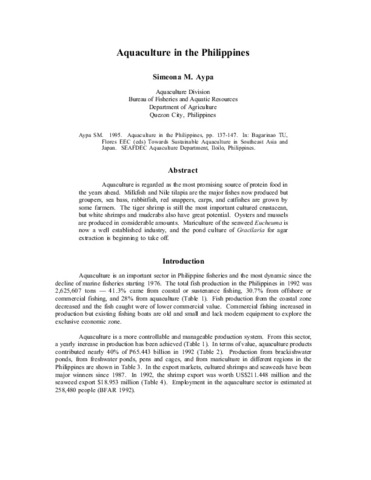| dc.contributor.author | Cuvin-Aralar, Maria Lourdes | |
| dc.contributor.author | Aralar, Emiliano V. | |
| dc.contributor.author | Laron, Manuel A. | |
| dc.contributor.author | Rosario, Westley | |
| dc.coverage.spatial | Bay, Laguna de | en |
| dc.date.accessioned | 2013-11-13T05:24:08Z | |
| dc.date.available | 2013-11-13T05:24:08Z | |
| dc.date.issued | 2007 | |
| dc.identifier.citation | Cuvin-Aralar, M. L. A., Aralar, E. V., Laron, M., & Rosario, W. (2007). Culture of Macrobrachium rosenbergii (De Man 1879) in experimental cages in a freshwater eutrophic lake at different stocking densities. Aquaculture Research, 38(3), 288-294. | en |
| dc.identifier.issn | 1355-557X | |
| dc.identifier.uri | http://hdl.handle.net/10862/1723 | |
| dc.description.abstract | Macrobrachium rosenbergii (de Man 1879) juveniles (0.4 g) were cultured in experimental cages (L × W × H: 2.5 × 1 × 1 m) in Laguna de Bay, the largest lake in the Philippines. The following stocking densities at four replicates each were used: 15, 30, 60 and 90 prawns m−2 of cage bottom. The mean sizes at harvest after 5 months of culture ranged from 14.3 g for the highest stocking density to 26.3 g for the lowest. The mean size at harvest, daily growth rate and size class distribution were significantly influenced by stocking density, with those at the lowest stocking density showing significantly better growth and overall proportion of larger prawns. Heterogeneous individual growth (HIG) was fairly evident in all treatments. The percentage of blue-clawed males was not influenced by treatment but the mean weight was significantly higher in the lower stocking densities. Both the percentage and mean weight of berried females were significantly higher in the lowest stocking density. Survival was the highest in the lower stocking densities (55.3%, 54.0%, 52.7% and 36.9% for 15, 30, 60 and 90 prawns m−2 respectively). Feed conversion ratio (FCR) improved with decreasing stocking density, ranging from 2.1 to 3. As expected, yield per cropping increased with stocking density and ranged from 450 to 1089 g m−2 yr−1 of actual cage area. Production values obtained in the cage cultured M. rosenbergii were comparable to or even higher than those reported from pond culture, given that the stocking densities used in this study were generally higher than in ponds. The results show that the farming of M. rosenbergii in cages in lakes is a viable alternative to pond culture and has the potential of improve aquaculture production in lakeshore fish farming communities. | en |
| dc.description.sponsorship | The authors thank Mr. Federico Reyes for his assistance in the conduct of this experiment. Funding was provided by SEAFDEC/AQD under study code: FS-05-C2003B. | en |
| dc.language.iso | en | en |
| dc.publisher | Blackwell Publishing | en |
| dc.subject | Macrobrachium rosenbergii | en |
| dc.subject | Philippines | en |
| dc.subject | Macrobrachium rosenbergii | |
| dc.title | Culture of Macrobrachium rosenbergii (De Man 1879) in experimental cages in a freshwater eutrophic lake at different stocking densities | en |
| dc.type | Article | en |
| dc.citation.volume | 38 | |
| dc.citation.issue | 3 | |
| dc.citation.spage | 288 | |
| dc.citation.epage | 294 | |
| dc.citation.journalTitle | Aquaculture Research | en |
| dc.subject.asfa | growth rate | en |
| dc.subject.asfa | stocking density | en |
| dc.subject.asfa | intensive aquaculture | en |
| dc.subject.asfa | eutrophic lakes | en |
| dc.subject.asfa | cage culture | en |
| dc.subject.asfa | pond culture | en |
| dc.subject.asfa | time | en |
| dc.subject.asfa | freshwater aquaculture | en |
| dc.subject.asfa | fish culture | en |
| dc.subject.asfa | cages | en |
| dc.subject.asfa | body weight | en |
| dc.subject.asfa | sex | en |
| dc.subject.asfa | salinity | en |
| dc.subject.asfa | water depth | en |
| dc.subject.asfa | temperature | en |
| dc.identifier.doi | 10.1111/j.1365-2109.2007.01667.x | |
| dc.subject.scientificName | Macrobrachium rosenbergii | |
| local.subject | cage culture | |
| local.subject | giant freshwater prawn | |
| local.subject | Laguna de Bay | |
| local.subject | Philippines | |
| local.subject | lake culture | |
| local.subject | Macrobrachium rosenbergii | |



